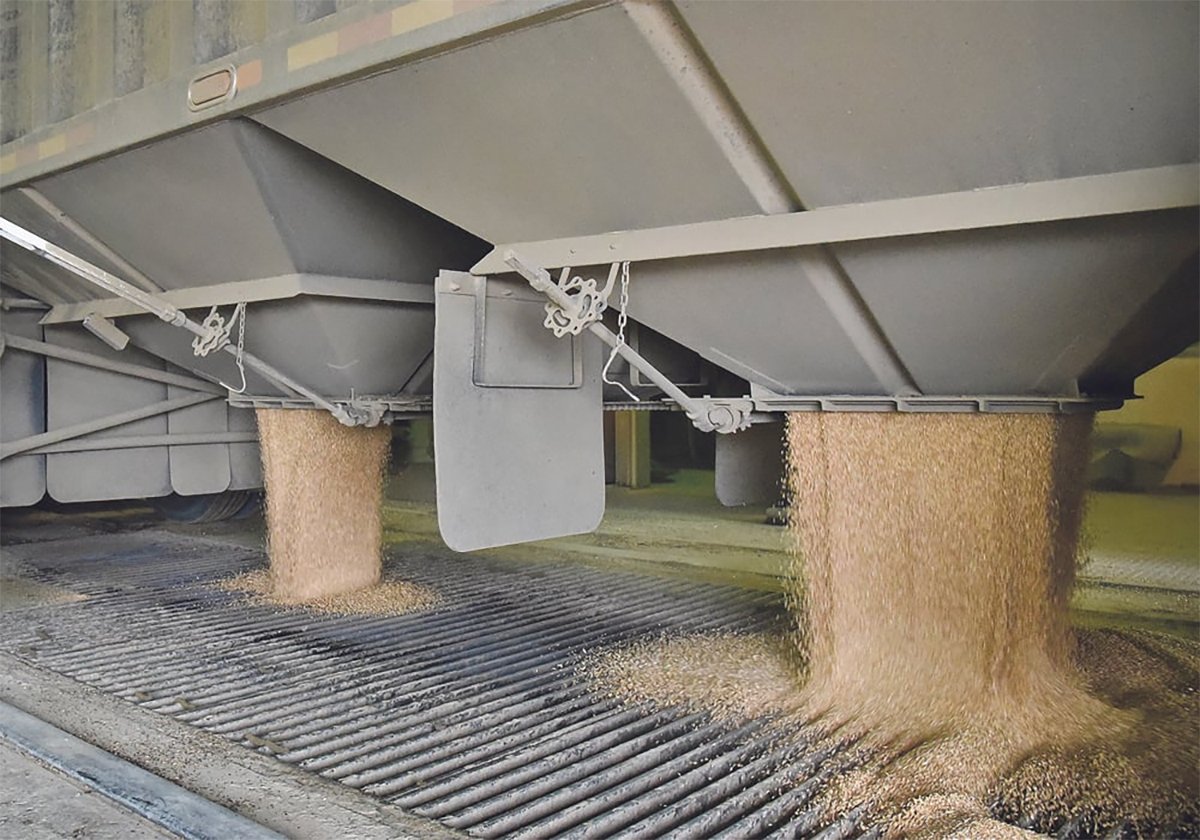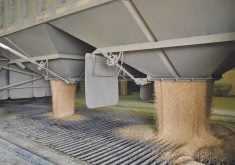Call to action
I write in full and wholehearted support of the article written by Wendy Holm in your Feb. 9 edition with regard to dual marketing vs. the Canadian Wheat Board.
There is little doubt that with the present configuration of the federal government, there will soon be a massive drive on the part of the dual marketers to get action to downgrade the CWB.
They will be using fine cliches like freedom of choice and less regulation, and their spin doctors will be using every method under the sun to achieve their results.
Read Also

Worrisome drop in grain prices
Prices had been softening for most of the previous month, but heading into the Labour Day long weekend, the price drops were startling.
Because this is such an important and vital issue to prairie farmers, it is an issue which should demand active and careful consideration by all farmers affected.
We have already seen the loss of many vital agricultural programs brought on by this group of so-called free marketers.
In the name of compliance to the free trade agreements, we were coerced into believing that the Crow Rate had to go. We were also told that the two-price system for domestic grain would have to be abandoned.
Well, they got their wish, the grain farmers are now faced with many millions of dollars in additional freight charges which continue to escalate, and have lost the benefit of the two-price system which used to provide a substantial premium on all locally consumed grain products.
There is no question in my mind that the loss of the single desk would result in the final destruction of the CWB. This entails much more than simply marketing. It also involves orderly marketing and movement of grain to terminals as required by the market. It also includes rigid quality standards, honest grading and the unquestioned quality of our products on the world market, which is one of our major selling advantages. All these are at risk, together with the loss of the premiums now achieved by the Board….
– Edgar Kaeding,
Churchbridge, Sask.
Emerson action
So the Liberals are giving it their best go in attempting to vilify … (David) Emerson and (Stephen) Harper. They have forgotten that when Belinda Stronach switched allegiance a short time ago, with far-reaching results, she was immediately enshrined in glorification. …
At least Emerson has a justifiable explanation for his actions. His constituents would be better off having a cabinet minister as their MP, rather than an opposition backbencher. By defecting, he is in a better position to continue his work in advancing key B.C. issues that are now part of his portfolio – the Canada-U.S. softwood lumber trade dispute, the 2010 Olympics and the Pacific Gateway strategy to boost trade with Asia…. So the Liberals should lighten up.
– Audrey Jensen,
Red Deer, Alta.
Cheap malt
An article in your Feb. 2 paper revealed that malt barley is being researched to produce a pint of Guinness at $6 a pint.
I recently had a locally brewed beer in a hotel in Saskatoon and that beer cost me $3.50. I read an article that claims 90 bottles of beer can be made from one bushel of malt barley.
The farmer receives $1.43 per bu. before elevating and production costs. That bushel of barley is now worth $315 in the bar.
Obviously brewing companies and government are reaping the benefit of cheap malt barley.
– Hugh Hedger,
Vanscoy, Sask.
Tags & costs
I’ll soon be tagging and processing calves. They seem to be getting quicker and stronger every year, or is it just me?
Well, we’ve succeeded in labelling our cattle so we can trace back to our farm and ranches of origin. Our system is getting world praise. Now we are supposed to birth date our calves to help with export markets. I understand.
What I don’t understand is why the meat packing business can’t upgrade their labelling. Animals that won’t make the export deadlines are down priced severely at the sale ring. These animals are all processed for domestic freezers and prime rib joints.
If a rancher can track down and tag a calf in the bush, why can’t a meat packer track down a carcass on the rail and price it according to what he bought it for?
History has shown us the three BSE cows generated huge profits for the meat packers on the backs of all our producers.
I hope our new government has its eyes open that the new rules aren’t used to generate profits for the few.
– Miles Moore,
Outlook, Sask.
CWB system
RE: reply to the article by Craig Docksteader, “History shows dual market works” (WP, Feb. 2).
There is no doubt that the two systems can exist in the same markets, but because they can do so does not mean that they will function for the maximum benefit of the producers.
First, can producers afford to support two systems? Everyone knows that the producers foot the bill for all your marketing services and have paid for every country elevator, every terminal at seaboard and most of the branch railway lines and a good part of the main lines as well.
Both the 1919 board and the 1935 board are compulsory boards and for a very good reason. Grain marketing and handling are volume related and the more volume, the cheaper they operate.
Even a casual look at the Canadian Wheat Board annual report will indicate the very low cost per bushel or tonne, not to mention reduced wasteful speculation.
Elections for the farmer board positions indicate that the majority of producers support single desk selling and this would indicate that the wheat board would get the majority of deliveries and probably better than 50 percent.
This would leave the balance in the hands of the grain exchange and would be a very thin market and probably would not be enough to generate or reflect the best price.
The CWB has provided 70 years of outstanding service to the producers of Western Canada and it is vastly different from what it was when first implemented, and now offers a lot of marketing options that producers have never had before, as well as marketing intelligence second to none….
In the hands of open market the premiums will go into the pockets of the grain companies.
– Aubrey B. Wood,
Ruthilda, Sask.
Wheat yield
I would like to express my opinion on my experience with CDC Imagine wheat with the Clearfield trait from BASF.
This wheat only produced about 30 bushels an acre while my homegrown wheat seeded along side of this field yielded double that amount. At present I have received a rebate on the chemical Adrenalin but nobody will acknowledge why the yield was so poor. All fields were fertilized as per soil tests.
Upon following the paper trail on the seed wheat, which was supplied by Agricore United, I received a copy of the germination test but it does not have a vigour test, which it seems is not compulsory.
I would advise all farmers to express their opinion on how much control they want chemical companies to have on the seed business because they want control but no responsibilities.
– Clifton White,
Irma, Alta.
It ain’t broke
I offer congratulations to the federal Conservative party as you have rightfully earned the opportunity to govern our fantastic country.
As a relatively young farmer, 43, I appreciate the marketing clout that the Canadian Wheat Board holds and I understand that the monopoly position of the CWB is essential in effectively maximizing returns for us farmers.
My Dad often gave this simple and direct advice: “If it ain’t broke, don’t fix it.”
The CWB is controlled and directed by farmer elected directors. Under the leadership of Ken Ritter, our board is proactive, market responsive and flexible in meeting the needs of farmers.
In other words, the CWB does not need fixing. It would be a shame to throw this all away by dismantling our board. …
I am one farmer that does not want to lose our monopoly, single desk position.
– Joe R. Cey,
Wilkie, Sask.
Ballot queries
Western Grains Research Foundation has received a number of questions regarding the ballot that has asked Saskatchewan organic growers to redirect their existing check-off dollars to establish the Saskatchewan Organic Commission. We appreciate the opportunity to clarify several points related to these questions and the information distributed with the ballot.
On the issue of research funding, it’s important organic producers know WGRF has responded to submissions by organic researchers over the last two years and is interested in continuing to support new projects that benefit organic farmers and low input agriculture.
WGRF funding of $10,000 per year for three years has recently been awarded to a new organic wheat breeding initiative led by Dr. Dean Spaner at the University of Alberta with collaboration from the Crop Development Centre, University of Saskatchewan. This funding is consistent with last year’s organic collections from the prairie wide checkoff that totalled just over $10,000 for wheat and barley combined.
WGRF checkoffs are collected from CWB administered sales of wheat and barley, ensuring low administrative costs so that the most dollars possible go toward research. Check-off dollars under the WGRF legislation could only be used for varietal breeding purposes, not marketing or other efforts as is suggested on the ballot.
In addition to direct funding of specifically organic projects, it is worth noting that organic farmers benefit from WGRF varietal development programs that select for disease and pest resistance, quality tailoring for niche markets and performance for low input production. Examples of varieties supported by WGRF include sawfly-resistant AC Lillian, leaf rust resistant AC Lovitt and the new niche market entry of Snowbird.
The value of WGRF-supported breeding systems to organic farmers is significant. It makes sense for organic farmers to make use of this western Canadian resource by encouraging scientists to submit more organic research project proposals for funding, and by continuing to work with the WGRF to identify needs and concerns for breeding.
In our view this would be more cost effective for organic farmers than redirecting their check-off dollars and developing an independent breeding system.
WGRF-established wheat varietal development programs are funded by class, with each class requiring $400,000 to $600,000 per year over a 10-year period to produce registered varieties. Start up costs for new programs as well as the 10-year lag time before new varieties enter the registration system are immense.
WGRF encourages organic producers to learn more about the checkoffs, their role and participation opportunities in this farmer funded and directed organization.
– Lanette Kuchenski,
Western Grains
Research Foundation,
Saskatoon, Sask.
CWB & competition
I’d like to respond to Ms. Wendy Holm’s article in the Western Producer (Feb. 9). As a grains and oilseed producer, third generation here in south-central Alberta, I know the challenges and opportunities that face me daily.
The fear mongering of Ms. Holm and others including the Canadian Wheat Board is no more than just that. Not once has the CWB come up with sound reasons why they cannot work in an open environment. Perhaps the word competition scares them?
They, as Ms. Holm points out, look back to an era where things were totally different, where farmers didn’t have adequate storage, aeration bins, large trucks, the ability to move their product not only to the nearest town but 100 kilometres away if the market directed them to. The grain producer of the 21st century is a businessperson capable of making their own decisions …. Access to various buyers via the internet or phone are so easily available.
Ms. Holm makes some grievous errors in her article, firstly the idea that the monopoly powers granted to the board by Mackenzie King gave farmers market leverage. Initially the board was voluntary. Then, after the Second World War, the federal government made it mandatory. This was not a benefit to producers. The federal government made a commitment to England to guarantee a supply of wheat at below market prices.
Our neighbours in the U.S. saw their prices for wheat increase dramatically while in Canada prices were kept at an all-time low.
Then we have the continual comments on the big bad multinationals. We have many Canadian grain companies, whether wholly owned or those who have strategic alliances with worldwide companies, to choose from. The CWB is completely dependent on these grain companies to acquire, store, blend and for the most part, market CWB grain.
Here the fear the CWB has about competition comes into play again. In canola, pulses, feed barley, all the companies vie for the right to get a producer’s grain. They have contacts and sell into the world market daily.
Last week at Agricore United’s annual members meeting, CEO Brian Hayward told delegates that AU has 70 countries it sells into. That means it has contacts in those countries, buyers there, financial guarantees in place to deal with those countries. I’d imagine Sask Pool, JRI and others have those arrangements as well.
Competition scare comes out clearly in another statement from Ms. Holm: “A two desk system for the export of wheat would destroy the CWB because short-term predatory pricing by concentrated grain buyers would bid grain away from the wheat board, breaking the back of the system.”
… Grain producers would have an opportunity to sell grain to a higher bidder, correct? Could the CWB compete to keep their market share? But they would have to get off their “forced” collective butts and get out there and hustle for product and markets….
Many challenges face western Canadian agriculture. With a new government I see hope, something we’ve been missing. …
We now have a more focused government when it comes to the World Trade Organization negotiations. We need to see the elimination of subsidies, unfair trade distorting tariffs and increase market access for producers in Canada to survive. We know that 90 percent of Canadian agriculture is either dependant on trade or dependant on the international market place to set the price.
Farmers have the right to choose to whom they sell, and they have the right to have that choice. If the CWB can compete, then it is one of many options for my farm. This is not short-term thinking for short-term gain. I’m looking for my farm’s viability not just next year, or the next five years but for the next generation and beyond.
– Doug McBain,
President,
Western Barley Growers,
Cremona, Alta.
Tax & Devine
Country people seem to have a penchant for cutting their own throats. Some think they can gamble on an open market with their grain.
Back in the 1920s when harvest time brought a drop in price, you had to sell to pay your bills. Later in the spring the price went up and you didn’t have any grain left to sell.
Some farmers may have a nickel in their pockets and now think they are big enough to play the markets with the multinational grain companies. Good luck, boys. Without the Canadian Wheat Board, you’ll need lots of it.
I agree with Don Scott (Open Forum, Jan. 19.) A voluntary wheat board would mean the end of an effective CWB.
On this tax revolt, I’m not sympathetic. So you don’t want to pay your taxes? Well, tough. Where’s the money to come from to run this province?
You want better schools, more money for teachers, better roads, etc. Inflationary pressure is constant in these times on most segments of the economy.
One hears that Saskatchewan is a “have” province. Have what? We are still carrying an $11 billion debt load thanks to Devine and his Conservatives, who ran up a $10.5 billion debt against the treasury, and $500 million is still flowing out of Saskatchewan in interest payments per year.
This is where the oil and gas revenue is going; revenue that would otherwise have gone to rebuild a road or a hospital. The Conservatives are like a rudderless ship swinging in whichever direction the wind blows. …
The Devine government bankrupted this province and we are still trying to recover from it.
– Louis Stetar,
Consul, Sask.
Wheat growers
For the last 35 years and even worse the last 10 years, Western Canadian Wheat Growers (Association) are helping 40 plus corporations to develop farm policies that (are) destroying family farms.
I will name a few corporate policies that WCWG A helped to develop.
1. Remove Crow Rate to add value. Never happened and farmers have high freight rates to move grain.
2. Two-price wheat system removed so bakers would have a cheap supply of grain.
3. Deregulation of farm policies and regulating rules and policies in favour of corporations.
4. Seed sector review, which will cost farmers money year after year to pay royalties to seed companies.
5. Canadian Wheat Board is thorn in grain companies’ side with help of WCWG.
If they happen to succeed in removing CWB, farmers of Canada would be at the mercy of grain companies….
WCWG should have learned a lesson what private companies did to the cattle industry a few years back; two cents a pound and in some cases farmers had to pay selling fees as there wasn’t any money left after the sale of cattle.
WCWG is misusing the farm group name. Therefore a name change is necessary as they represent and lobby on behalf of 40 plus corporations against and divide farmers and other farm organizations.
– Eric Sagan,
Melville, Sask.
GURT objection
While Canadians were pre-occupied with the election, non-elected government bureaucrats were again advancing the corporate interests of multinational chemical/seed companies.
On Jan. 27, in Granada Spain, at a meeting of the United Nations Convention on Biological Diversity, Canada played a leading role in reversing the UN’s moratorium on GURTs (Genetic Use Restrictions Technologies), commonly known as terminator technology or suicide seeds.
Bizarre as it seems, this technology genetically modifies plants to produce sterile seeds. Why would anyone want to do that, you ask? Well, as always, we need to follow the money.
For generations, farmers around the world have saved their best seed for next year’s planting. This was an intentional practice, because it ensured the best possible crop, weather permitting. It has been the natural order of things for eons. …
But this tradition has the potential to be undermined because of the actions of Canada’s government officials who sided with the governments of Australia and New Zealand at this recent meeting in Spain. …
As we learned from GM canola, seeds don’t stay around in the back yard. They move by wind, water and all manner of transport. Terminator or suicide seeds will do the same thing. Inevitable dispersal will ultimately mean their cross pollination and cross contamination with traditional varieties. As we know with canola, there is no clean genetic well to go back to. Most if not all the basic seed stocks of canola are now contaminated with GM genes. The incredible risk of cross contamination with this terminator trait could only be desirable to powerful corporate seed companies that want even more control. This is a genie that all our scientific smarts cannot put back in the bottle. …
We are seeing a major shift in UN policy on biodiversity. This shift is away from the precautionary principle of serving the public interest to a policy of serving the long-term financial interests of chemical/seed companies of controlling development and ownership of seed varieties that are at the foundation of the food system. …
Our newly elected government needs to do some house cleaning of some powerful bureaucrats and decide in whose interests seed production and control should rest with. Write your letter, and let your newly elected representatives know how you feel. This same UN meeting on biodiversity will convene yet again in Brazil this coming March 20.
Together we can change the outcome.
– K. Norman Dyck,
Grande Prairie, Alta.
Midlife orphans
In response to Noel McNaughton’s Jan. 26 column, feeling like an orphan at midlife, I clearly recall saying that to my husband after my dad died.
Suddenly my siblings and I had become the senior level of family, the wise, experienced, thoughtful bunch that whippersnappers amused themselves making jokes about at family reunions.
– Claudette Sandecki,
Terrace, B.C.
Part-timers
Some months ago, the (Saskatchewan) government attempted to pass legislation that would limit the number of part time employees that larger businesses (of more than 50 employees) could have on their payroll.
A coalition of groups, mainly the Chamber of Commerce, the Independent Business Association and Brad Wall’s Saskatchewan Party let it all hang out, so to speak, in opposition to this legislation. We all know what happened next. The NDP ran for cover, much to the dismay of labour groups.
Now, fast forward to the present. Safeway hires almost 300 part time employees. Safeway’s John Graham stated there will be a considerable saving for Safeway because many of the new workers will be starting at the bottom of the wage scale.
Pretty smart idea, eh? Replacing senior employees with low paid part timers. It makes sense that business owners would be delighted with such an opportunity to save money on wages and benefits. But what happens to workers and their families?
One word of caution to Brad Wall and his Saskatchewan Party. Do you really think the workers of this province will soon forget who is the big kingpin in this squeeze on their standard of living?
– Henry Neufeld,
Waldeck, Sask.
Goodbye, CWB
Now that we have federal Conservatives to back Alberta farmers, we need to remind both leaders of commitments for a voluntary wheat board.
Stephen Harper may be tempted to opt out because the Canadian wheat Board is at the top of the cash cow list. A net profit of $4.2 billion in 2002 was the highest for any Canadian company, which is why the Liberals refused to give it up.
Ralph Klein, on the other hand, may be dissuaded by a self-proclaimed majority who still believe the monopoly is the greatest thing since prisons were invented. Most Albertans, however, realize that if a plebiscite were held tomorrow, the result would be … over 60 percent of farmers in favour of dual marketing. …
Our world quality milling wheat has dropped to $6, equivalent to 1970s prices, while trucking and all the bogus charges to port have multiplied significantly, leaving us with only $3 or so.
Why are we not receiving world prices for domestic grain and what are farmers supposed to do with mountains of feed wheat when CWB prices are continually 50 cents to $1 below the open market?
And quite frankly, your crop insurances and likewise federal subsidy programs stink. A few farmers have been doing OK farming crop insurance and now they are farming CAIS (Canadian Agricultural Income Stabilization.) Who can blame them?
But the fact is, the rest of us dimwits who work honestly and diligently are always left out in the cold.
When will you governments ever learn? The only fair way to help farmers is exactly what other world governments have been doing for years, a floor price based on the cost of production. Your excuse has been the World Trade Organization doesn’t allow this, but just who is this WTO other than a number of governments just like yourselves who are intent on a cheap world food policy which allows prices to be manipulated by huge profits on the futures and has no concern for producers? …
– L. K. Berg,
Sedalia, Alta.
No dual market
I see there are farmers who believe that there should be a dual marketing system for our wheat and barley.
I would ask how the Canadian Wheat Board can exist under such a system. You say “the same as Ontario.” This is not the same case; Ontario processes 90 percent of their wheat and maybe exports 10 percent. Western Canada exports 90 percent of its wheat and processes 10 percent.
Let’s put figures on paper. We are getting $3 a bushel for our wheat and $2.60 a bu. for durum in our pockets through the CWB. This should represent about 80 percent of the value of grain.
If we have elevator companies buying grain, they probably pay $3.50 a bu., because they are financially able to. We know most farmers will take $3.50 a bu. and run. The CWB will be out of business. But wait. After this happens, the grain companies will lower their prices as they do not have to compete with the CWB. So there is no dual marketing system.
We will be at the mercy of big international companies. Will they sell Canadian wheat first or U.S. wheat? We see what has happened to canola. It is about $5 a bu. competing with U.S. soybeans. We also will not have an orderly movement of wheat as there will be no quota system and there will be no cash advance.
If farmers think they can haul across the U.S. border, they will be charged for dumping grain and the border will be closed. …
If any farmer thinks we should have a dual marketing system, put some figures on paper to show me how the wheat board can exist. I predict the end of the board in one year with a dual marketing system….
– Frank Gechter,
Medicine Hat, Alta.














